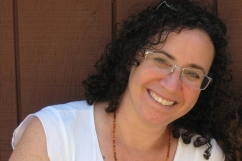



Photos and text used with permission
of Lori Marx-Rubiner
At the end of 2001 life was on track. Our son had just turned three, we were on our chosen career paths, and we were meeting all those expectations we had set up for ourselves. I was only 35, but my internist felt it was a good time to get a baseline mammogram and then I wouldn't have to think about it for five years.
Two months later I sat in front of the surgeon who delivered my cancer diagnosis, who watched me cry and told me it wasn't going to be helpful. I didn't realize it then, but that was the day I became a breast cancer advocate.
Like so many, I went through chemo, surgery, and then hormonal therapy. By 2007, I was done with treatment and NED - no evidence of disease. They are the best three letters any cancer patient can hear. I believed it was all behind me, that I had survived my "brush with death" and learned my lessons. I began to live the "new normal" people think of.
From this new perspective, I came to realize how much was wrong in the world of breast cancer. It seemed as if, despite the walks and products and "pink washing," we weren't much closer to a cure than we had been when Nixon started our country's War on Cancer in 1971:
- Too many women were diagnosed late - especially young women.
- Too many patients didn't have targeted therapies - especially those with Triple Negative Breast Cancer.
- Too many people became metastatic - roughly 30%.
- And far too many were dying.
It wasn't easy to find a place for my advocacy in the sea of pink, but I soon discovered the National Breast Cancer Coalition (NBCC) and landed at their annual Advocacy Conference. They didn't accept the messages about making progress; they saw the world as I did, and they shared my urgency. They put me on a bus, drove me to Capitol Hill, and taught me how to talk to our elected officials about the real state of breast cancer, and the dire need for research funds.
In 2010 I graduated from Project LEAD Institute, NBCC's incredible effort to teach patient advocates the science behind breast cancer. I have to admit, I was skeptical - science was never my best subject. But with expert researchers, patient leadership, and others who arrived as lost as I felt, they did quite an impressive job. We learned the basics of cancer biology, clinical trial design, and perhaps most significantly, we learned how to ask pointed, critical questions from the perspective of the end users of this research: the patient.
NBCC also introduced me to the Department of Defense Breast Cancer Research Program, which at its inception laid out a new model for the partnership between consumers and scientists. I have had the honor of serving as a consumer advocate for four years, where I have been continuously challenged. I have been welcomed to the table as a partner with the country's leading scientists, where my unique perspective is honored and my priorities are heard.
When I was diagnosed I truly believed that "you have cancer" were the worst words I would ever hear. I was wrong. In August 2011, just months before our son's bar mitzvah, I got the call every cancer patient dreads. "There's evidence of spread," my doctor explained. A subsequent biopsy showed cancer in my bones.
At 48 years old I have outlived my life expectancy and my devotion to advocacy has continued to grow. In addition to my role with the DoD, I serve as President of METAvivor, the only non-profit in America that awards peer-reviewed only metastatic-specific breast cancer research grants. I work one-on-one with patients who are newly diagnosed as they deal with the myriad of challenges and questions they face. And I continue to write and speak to raise greater awareness of what it means to live with metastatic breast cancer. I am grateful for the opportunity to learn more and to share my voice, in whatever capacity I can.
We need more than awareness. We need more than hope. We need to save lives. We need the science funded by the DoD to end this disease.
Last updated Thursday, December 5, 2024














